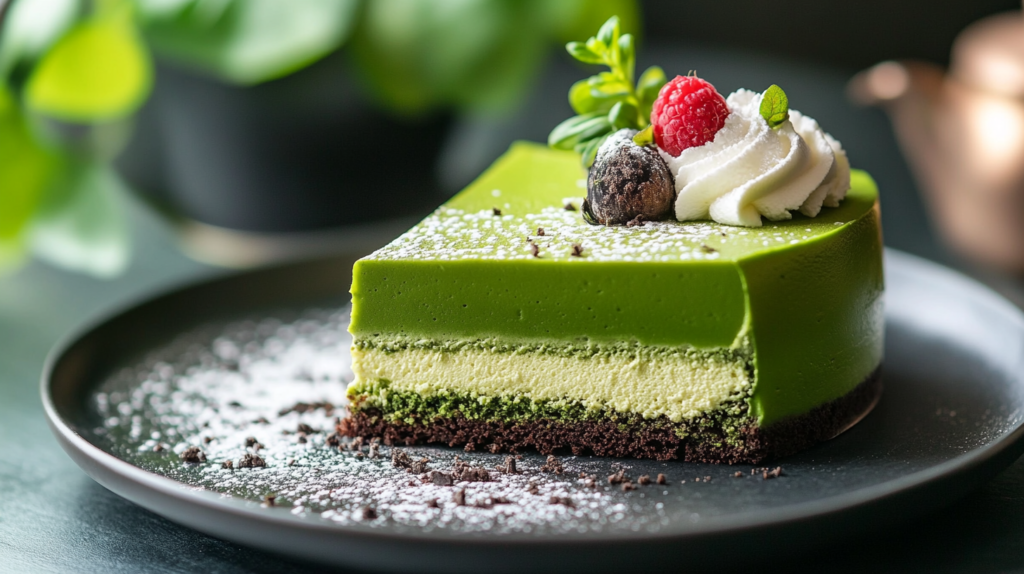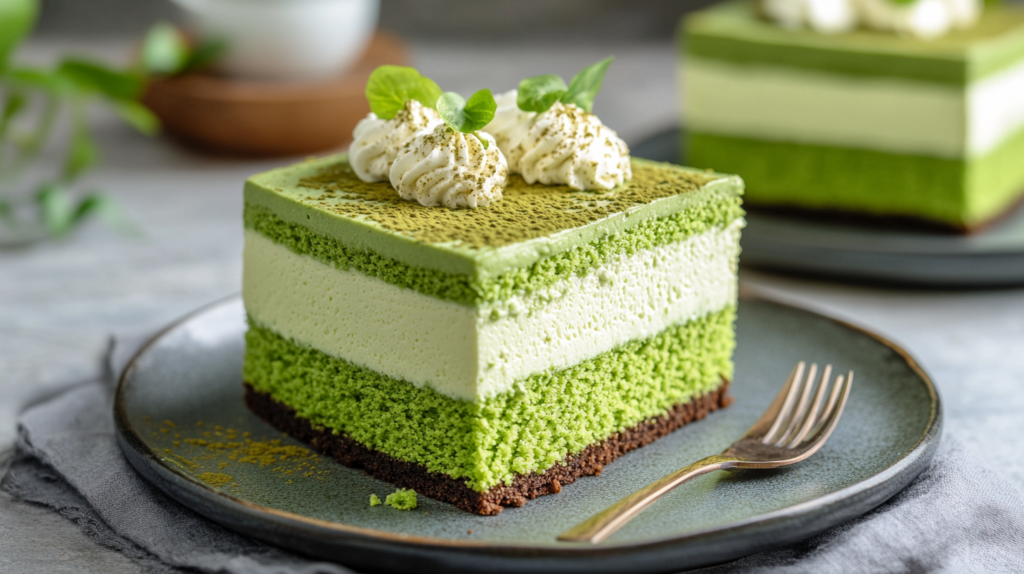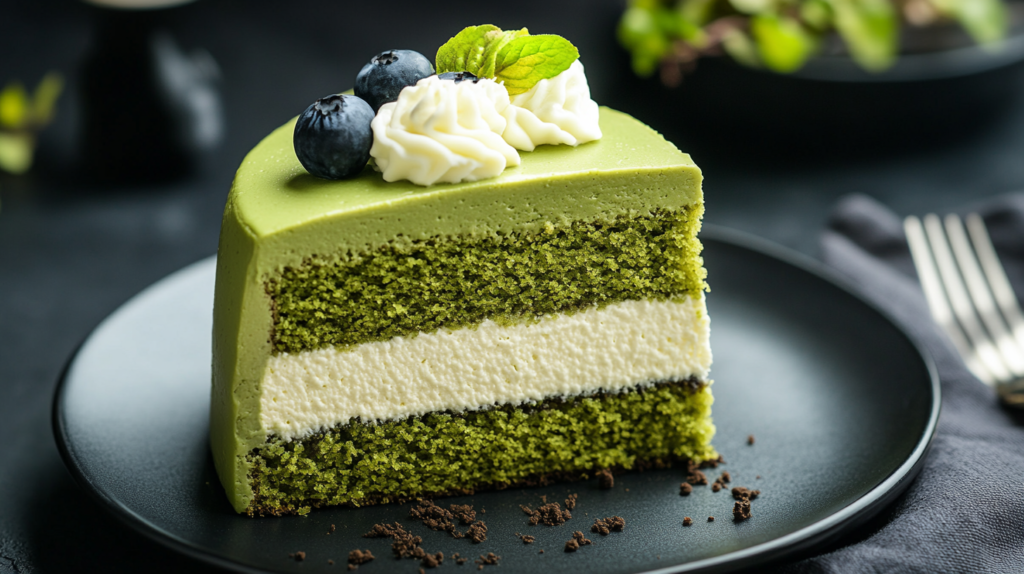Introduction to Matcha Mousse Cake
What is Matcha Mousse Cake?
Matcha mousse cake is a delectable dessert that blends the bold, earthy flavor of matcha (green tea powder) with the creamy, airy texture of mousse. This cake typically consists of layers or combinations of matcha-infused mousse and a complementary base, such as sponge cake, biscuit crust, or even a matcha-flavored genoise. The vivid green hue of matcha gives the cake a visually striking appearance, while its unique flavor balances sweetness with the subtle bitterness characteristic of green tea.
This dessert is a favorite among matcha enthusiasts and dessert lovers alike, celebrated for its light yet indulgent texture and the sophisticated, nuanced flavor profile it offers.
The Origins of Matcha and Its Incorporation in Desserts
Origins of Matcha
Matcha has its roots in ancient Japan, where it was first introduced during the 12th century by Zen Buddhist monks. Traditionally used in tea ceremonies, matcha is made from finely ground, shade-grown green tea leaves. Its preparation involves a meticulous process to ensure a vibrant green color and a concentrated flavor profile, combining umami, sweetness, and a hint of bitterness.
Over time, matcha transcended its ceremonial role and became a popular ingredient in modern cuisine, thanks to its versatility and health benefits. Rich in antioxidants, vitamins, and minerals, matcha has earned global recognition as a superfood.
Matcha in Desserts
Matcha began appearing in desserts as part of Japanese culinary traditions, where it was used to flavor wagashi (traditional Japanese sweets). Its integration into Western-style desserts gained popularity in recent decades, fueled by the global appreciation of matcha’s distinct taste and aesthetic appeal.
Today, matcha mousse cake exemplifies the fusion of Eastern and Western culinary traditions, showcasing matcha’s versatility in contemporary dessert-making. The cake combines the richness of mousse with the refreshing, earthy notes of matcha, making it a sophisticated treat enjoyed worldwide.
Key Ingredients for Matcha Mousse Cake
High-Quality Matcha Powder
Matcha powder is the star ingredient of mousse cake, giving the dessert its signature flavor and vibrant green color. To ensure the best taste and texture, it’s important to use high-quality matcha:
- Ceremonial Grade vs. Culinary Grade: While culinary-grade matcha works well for baking and cooking, opting for a high-quality culinary grade or even ceremonial-grade matcha ensures a smoother, less bitter flavor ideal for desserts like mousse cake.
- Flavor Profile: Premium matcha provides a balanced taste with earthy, umami notes and a natural sweetness that complements the cake’s creamy components.
- Color: High-quality matcha delivers a bright, vivid green hue that enhances the cake’s visual appeal.
Tips for Selecting Matcha:
- Look for matcha with a fine, silky texture and a vibrant green color.
- Ensure the matcha is fresh by checking the packaging date and storing it in an airtight container to prevent oxidation.
Essential Components for the Mousse and Cake Base
Mousse Layer
The mousse is the creamy, airy layer that gives the cake its light and luscious texture. Key ingredients for the matcha mousse include:
- Heavy Cream: Whipped cream provides the mousse’s fluffy texture and rich taste.
- Sugar: Adds sweetness to balance matcha’s slight bitterness.
- Gelatin: Helps set the mousse, ensuring it holds its shape while maintaining a silky consistency.
- Matcha Powder: Infused into the cream, matcha brings its unique flavor and vibrant green color to the mousse.
Cake Base
The base of the matcha mousse cake can vary, but some common choices include:
- Sponge Cake: A light, fluffy layer made with eggs, flour, sugar, and sometimes matcha for a cohesive flavor.
- Biscuit or Cookie Crust: A no-bake option made by combining crushed cookies (e.g., graham crackers or digestive biscuits) with melted butter.
- Matcha Genoise: A Japanese-style cake base infused with matcha for a more pronounced flavor.
Additional Ingredients
- Milk: Used to dissolve matcha and blend it evenly into the mousse mixture.
- Vanilla Extract: A touch of vanilla enhances the overall flavor profile.
- Optional Toppings: Whipped cream, matcha dusting, fresh fruit, or white chocolate shavings can add a decorative and flavorful finish.
By combining high-quality matcha with these essential components, the mousse cake achieves its signature balance of earthy, sweet, and creamy flavors, making it a delight for both the eyes and the palate.
Choosing the Right Matcha Powder
Ceremonial vs. Culinary Grade Matcha
When selecting matcha powder for a mousse cake, understanding the differences between ceremonial and culinary-grade matcha is essential. Each type is suited to specific uses and delivers unique flavor profiles.
Ceremonial Grade Matcha
- Purpose: Traditionally used for tea ceremonies, ceremonial-grade matcha is meant to be enjoyed as a standalone drink.
- Flavor: It has a smooth, delicate flavor with natural sweetness and minimal bitterness.
- Color: Bright, vibrant green, indicating high chlorophyll content from shade-grown leaves.
- Usage: While it can be used in desserts, it’s best reserved for recipes where matcha is the star ingredient and not mixed with strong flavors.
- Price: Typically more expensive due to its high quality and labor-intensive production process.
Culinary Grade Matcha
- Purpose: Designed for cooking and baking, culinary-grade matcha is slightly more robust in flavor.
- Flavor: Stronger, slightly bitter notes that can hold up against other ingredients in recipes.
- Color: Green but may be less vibrant compared to ceremonial-grade matcha.
- Usage: Ideal for desserts like matcha mousse cake, where its bold flavor balances with sugar and cream.
- Price: More affordable than ceremonial-grade matcha, making it a practical choice for everyday use in recipes.
Which to Choose for Matcha Mousse Cake?
For a matcha mousse cake, high-quality culinary-grade matcha is generally the best choice. It provides a strong enough flavor to stand out without being overpowered by other ingredients, while still being cost-effective for use in larger quantities.
Tips for Identifying Authentic Matcha
To ensure you’re using authentic and high-quality matcha, consider these tips:
- Check the Origin:
- Authentic matcha comes from Japan, particularly regions like Uji, Kyoto, or Nishio, known for producing premium matcha.
- Look for labeling that specifies the matcha’s region of production.
- Examine the Color:
- High-quality matcha is a vibrant, bright green.
- Dull or yellowish-green matcha may indicate poor quality or oxidation.
- Texture:
- Matcha should be finely milled to a powder-like consistency. A gritty texture suggests lower-quality production.
- Taste and Aroma:
- Good matcha has a slightly sweet, earthy, and grassy aroma.
- Authentic matcha balances umami and mild sweetness with minimal bitterness.
- Packaging:
- Look for airtight packaging, as matcha is highly sensitive to light and air, which can degrade its flavor and color.
- Ingredients:
- The only ingredient should be 100% pure matcha green tea powder. Avoid products with added sugars or fillers.
By choosing the right grade and ensuring authenticity, you can maximize the flavor, color, and overall quality of your matcha mousse cake.

Step-by-Step Recipe for Matcha Mousse Cake
Preparing the Cake Base
The base of a matcha mousse cake can be a soft sponge cake or a no-bake crust. Here’s how to prepare each option:
Option 1: Matcha Sponge Cake Base
Ingredients:
- 2 large eggs
- 1/3 cup (70g) granulated sugar
- 1/4 cup (30g) all-purpose flour
- 1 tablespoon matcha powder
- 1/4 teaspoon baking powder
- 2 tablespoons milk
- 1 tablespoon vegetable oil
Instructions:
- Preheat and Prepare: Preheat your oven to 350°F (175°C). Line the bottom of a springform pan (about 7–8 inches) with parchment paper.
- Whisk Eggs and Sugar: Beat the eggs and sugar using a hand mixer until light, fluffy, and tripled in volume.
- Sift Dry Ingredients: Sift the flour, matcha powder, and baking powder into the egg mixture, folding gently with a spatula to avoid deflating the batter.
- Incorporate Milk and Oil: Combine the milk and oil, then gently fold them into the batter.
- Bake: Pour the batter into the prepared pan and bake for 12–15 minutes or until a toothpick comes out clean.
- Cool: Allow the cake to cool completely in the pan before adding the mousse layer.
Option 2: No-Bake Biscuit Crust
Ingredients:
- 1 cup (100g) crushed graham crackers or digestive biscuits
- 3 tablespoons melted butter
Instructions:
- Mix: Combine the crushed biscuits with melted butter until the mixture resembles wet sand.
- Press into Pan: Firmly press the mixture into the bottom of a springform pan, creating an even layer.
- Chill: Refrigerate the crust for 15–20 minutes to set before adding the mousse.
Creating the Silky Matcha Mousse
Ingredients:
- 1 tablespoon matcha powder
- 2 tablespoons warm water
- 1/2 cup (120ml) whole milk
- 1 teaspoon vanilla extract
- 1 teaspoon gelatin powder
- 2 tablespoons cold water
- 1/4 cup (50g) granulated sugar
- 1 cup (240ml) heavy cream (chilled)
Instructions:
- Dissolve Matcha:
- Mix the matcha powder with warm water until smooth, creating a matcha paste. Set aside.
- Bloom Gelatin:
- In a small bowl, sprinkle the gelatin powder over cold water. Let it sit for 5 minutes to bloom.
- Heat the Base:
- In a saucepan, warm the milk, sugar, and vanilla extract over low heat until the sugar dissolves. Remove from heat and stir in the bloomed gelatin until completely dissolved.
- Combine Matcha:
- Whisk the matcha paste into the milk mixture until smooth and evenly colored. Let it cool to room temperature.
- Whip the Cream:
- In a separate bowl, whip the chilled heavy cream to soft peaks using a hand mixer or whisk.
- Fold Together:
- Gently fold the cooled matcha mixture into the whipped cream in batches, ensuring a smooth and airy mousse.
- Assemble the Cake:
- Pour the matcha mousse over the prepared cake base or biscuit crust, smoothing the top with a spatula.
Final Touches
- Chill: Refrigerate the assembled cake for at least 4–6 hours, or until the mousse is fully set.
- Decorate: Dust the top with matcha powder, or garnish with whipped cream, white chocolate shavings, or fresh fruit for a beautiful presentation.
Your matcha mousse cake is now ready to serve! Slice and enjoy this elegant, creamy dessert with its perfect balance of earthy matcha and sweet creaminess.
Frequently Asked Questions About Matcha Mousse Cake
What is Matcha Mousse Cake?
Matcha mousse cake is a sophisticated dessert made by layering light and creamy matcha-infused mousse over a cake base, such as sponge cake or a biscuit crust. Its vibrant green color and unique flavor—earthy, slightly bitter, and sweet—make it a popular choice for tea lovers and dessert enthusiasts alike.

How Do I Make Matcha Mousse Cake?
To make mousse cake, follow these basic steps:
- Prepare the Base: Choose between a baked matcha sponge cake or a no-bake biscuit crust.
- Create the Matcha Mousse: Whisk dissolved matcha powder into a milk-gelatin mixture, fold it into whipped cream, and combine until smooth.
- Assemble: Pour the mousse over the prepared base, smooth the top, and refrigerate until set.
- Decorate: Dust with matcha powder or garnish with fresh fruit, whipped cream, or chocolate shavings.
For detailed instructions, see the Matcha Mousse Cake Recipe.
What is the Difference Between Matcha Mousse Cake and Matcha Chocolate Mousse Cake?
Matcha mousse cake focuses solely on the flavor of matcha, while matcha chocolate mousse cake combines the earthy taste of matcha with the richness of chocolate.
- Matcha Mousse Cake: Layers of matcha mousse over a simple cake base or crust.
- Matcha Chocolate Mousse Cake: Includes alternating layers of matcha mousse and chocolate mousse or incorporates melted white or dark chocolate into the mousse.
The addition of chocolate enhances sweetness and adds a creamy texture, making it a great option for those who enjoy matcha with a sweeter twist.
What Tips Can Help Perfect My Matcha Mousse Cake Recipe?
- Use High-Quality Matcha: Select culinary-grade or ceremonial-grade matcha for a vibrant color and smooth flavor.
- Bloom Gelatin Properly: Ensure the gelatin is fully dissolved in the milk mixture to avoid lumps.
- Whip Cream Gently: Overwhipping cream can make the mousse grainy, so stop at soft peaks for a smooth texture.
- Chill Thoroughly: Let the cake set in the refrigerator for at least 4–6 hours to achieve a firm and stable mousse layer.
- Balance Flavors: Adjust the sweetness to taste, especially if using bitter matcha powder.
Can I Add Chocolate to Matcha Mousse Cake?
Yes! Chocolate pairs beautifully with matcha. For a chocolate mousse cake, you can:
- Add melted white chocolate to the matcha mousse for a sweeter, creamier texture.
- Layer dark chocolate mousse with matcha mousse for a bold flavor contrast.
- Use a chocolate sponge base instead of plain sponge or biscuit crust.
This combination highlights the unique flavor of matcha while adding richness from the chocolate.
mousse cake, with its light texture and complex flavor, is a versatile dessert that can be customized to suit any occasion or taste. Whether you stick to the classic recipe or experiment with chocolate variations, it’s sure to impress!
1 https://recipes4hub.com/make-lemon-dill-sauce-in-just-minutes/
2 https://recipes4hub.com/cold-shrimp-appetizers-quick-fresh-irresistible/
3 https://recipes4hub.com/easy-buffalo-chicken-dip-no-cream-cheese-needed/



